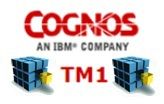One of the key security-related selling points within IBM Cognos TM1 is the tool’s ability to...
How Do TM1 Financial Systems Ensure Clean Data?
Summary
Almost half of new business initiatives fail because of poor data, according to a recent article on the EPM Channel website. While manual processes can temporarily fix issues, The IBM TM1 technology uses a series of checks and balances to ensure that businesses can build a database on clean data, saving employees time and avoiding costly mistakes.
How Do TM1 Financial Systems Ensure Clean Data?
Almost half of new business initiatives fail because of poor data, according to a recent article on the EPM Channel website. This trend fuels mistakes in everything from bill payments to shipping, and often means that your best employees spend more time organizing data instead of analyzing it.
 This is a long-standing pain a lot of businesses incur with dirty data. With Big Data, businesses have large amounts of data, so the quality of that comes into question. Organizations often are looking at ways to improve their data because they have too many manual processes in place or their data is being cleaned in a non-automated fashion. If your data is clean and organized, you’ll streamline processes and align the organization on a set of numbers. As the EPM Channel article points out, it’s best to do this at the start, saving employee resources and avoiding costly problems.
This is a long-standing pain a lot of businesses incur with dirty data. With Big Data, businesses have large amounts of data, so the quality of that comes into question. Organizations often are looking at ways to improve their data because they have too many manual processes in place or their data is being cleaned in a non-automated fashion. If your data is clean and organized, you’ll streamline processes and align the organization on a set of numbers. As the EPM Channel article points out, it’s best to do this at the start, saving employee resources and avoiding costly problems.
There are systems that can help. TM1 financial solutions enforce what’s called referential integrity in data. Many times, when pulling data to put into TM1, there are problems in supporting systems that must be fixed. For instance, if you’re pulling data from a financial system that’s doing consolidations, there could be numbers at an account level that do not necessarily total to the parent account that they should roll up into. That’s because the system allows users to store two different numbers. This means there are a number of child accounts that fail to add up to the appropriate total because the database doesn’t enforce referential integrity.
Most relational databases or ERP applications don’t necessarily enforce these rules. They try to put business rules in place, but fundamentally the technology allows users to enter data in different places, creating conflicting information. When pulling data into the TM1 financial systems software, the detail-level account data rolls up into the parent account, creating that figure. This method ensures that the parent figure isn’t entered separately and avoids any situations where the child accounts don’t add up to the parent number. Therefore, users who leverage TM1 as there database are much more likely to have quality, clean data.
To learn more about TM1 financial solutions or see a TM1 demo contact ACG.


